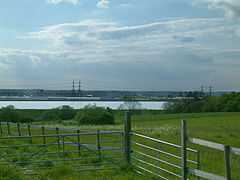King George V Reservoir
| King George V Reservoir | |
|---|---|
 Looking west across the reservoir | |
| Location | London Borough of Enfield |
| Coordinates | 51°39′00″N 0°00′58″W / 51.6499°N 0.0161°WCoordinates: 51°39′00″N 0°00′58″W / 51.6499°N 0.0161°W |
| Type | reservoir |
| Basin countries | United Kingdom |
| Surface area | 170 ha (420 acres) |
| Max. depth | 7.5 m (25 ft) |
| Water volume | 12.45 Gl (2.74×109 imp gal) |
The King George V Reservoir, also known as King George's Reservoir, is located in the London Borough of Enfield and is part of the Lee Valley Reservoir Chain that supplies London with drinking water. The storage reservoir is bordered by Sewardstone and Chingford to the east and Brimsdown and Ponders End to the west, and covers 420 acres (170 hectares), making it the largest in London.[1] The reservoir and the nearby William Girling Reservoir are known collectively as the Chingford Reservoirs, and are owned and managed by Thames Water.
History

The reservoir was conceived as part of an overall plan for the Lea Valley and was laid before the Royal Commission on Water Supply (Balfour Committee) in 1893. At this time the responsible authority was the East London Waterworks Company. However, under the Provisions of the Metropolis Water Act of 1902, the undertakings of this as well as seven other companies were transferred to the Metropolitan Water Board.
Construction was started in 1908 and completed in 1912. The reservoir was opened by H.M.King George V in 1913, hence the name.
Description
The reservoir was formed by the construction of a continuous embankment on the floodplain of the River Lea at Chingford. An earth embankment divides the reservoir into two compartments that are connected by three large diameter culverts. The external grassed embankment consists of a central puddle clay core with shoulder filling comprising a mixture of river terraced gravels and alluvial deposits.
Located in the NW corner is the original inlet pumping station by W.B. Bryan and finished in red brick and Portland stone. Still in situ are three of the five gas-fuelled liquid-piston pumps designed by H A Humphrey. In 1970 these were made redundant by the installation of a vertical spindle electric pump.[2]
Ecology
The water is part of the Chingford Reservoirs Site of Special Scientific Interest (SSSI).[3] It is a major wintering ground for wildfowl and wetland birds, including nationally important numbers of some species. The water also forms a moult refuge for a large population of wildfowl during the late summer months. A total of 85 wetland species have been recorded here in recent years.
Recreation
The reservoir is popular with birdwatchers,[4] and is home to the King George Sailing Club. Permits and a key are required to visit the water. Both can be obtained from Thames Water.[5]
Water supply
Water is supplied to the reservoir from the New River and the River Lee Diversion.[6]
Access
Vehicular access is at Lea Valley Road A110
See also
References
- ↑ The Buildings of England London 4: North pp 441 ISBN 0-14-071049-3 Retrieved December 21, 2007
- ↑ Smith. D Civil Engineering Heritage 2001 pp 69.70 ISBN 0-7277-2876-8 Retrieved December 22, 2007
- ↑ English Nature citation, Chingford Reservoirs Retrieved December 21, 2007
- ↑ Thames Water Retrieved December 21, 2007
- ↑ Thames Water birdwatching permits Retrieved 12 July 2010
- ↑ pp3 Reservoir information Retrieved December 21, 2007
Literature
- A Poacher's Tale. Told by A.T. Curtis. Related by Fred J Speakman. Includes several references to the reservoir. ISBN 0-7135-0969-4. Published 1960 by George Bell & Sons.
- An Edmonton Boy by Terry Webb. Reference to the reservoir on page 36. ISBN 1-903981-00-X. Published 2000 by Biograph.
External links
| Wikimedia Commons has media related to King George V Reservoir. |
- British dams
- King George Sailing Club
- The Humphrey pump
- National Archives-H A Humphrey
- English Nature, Chingford Reservoirs citation
- English Nature, Nature on the Map, Chingford Reservoirs
| ||||||||||||||